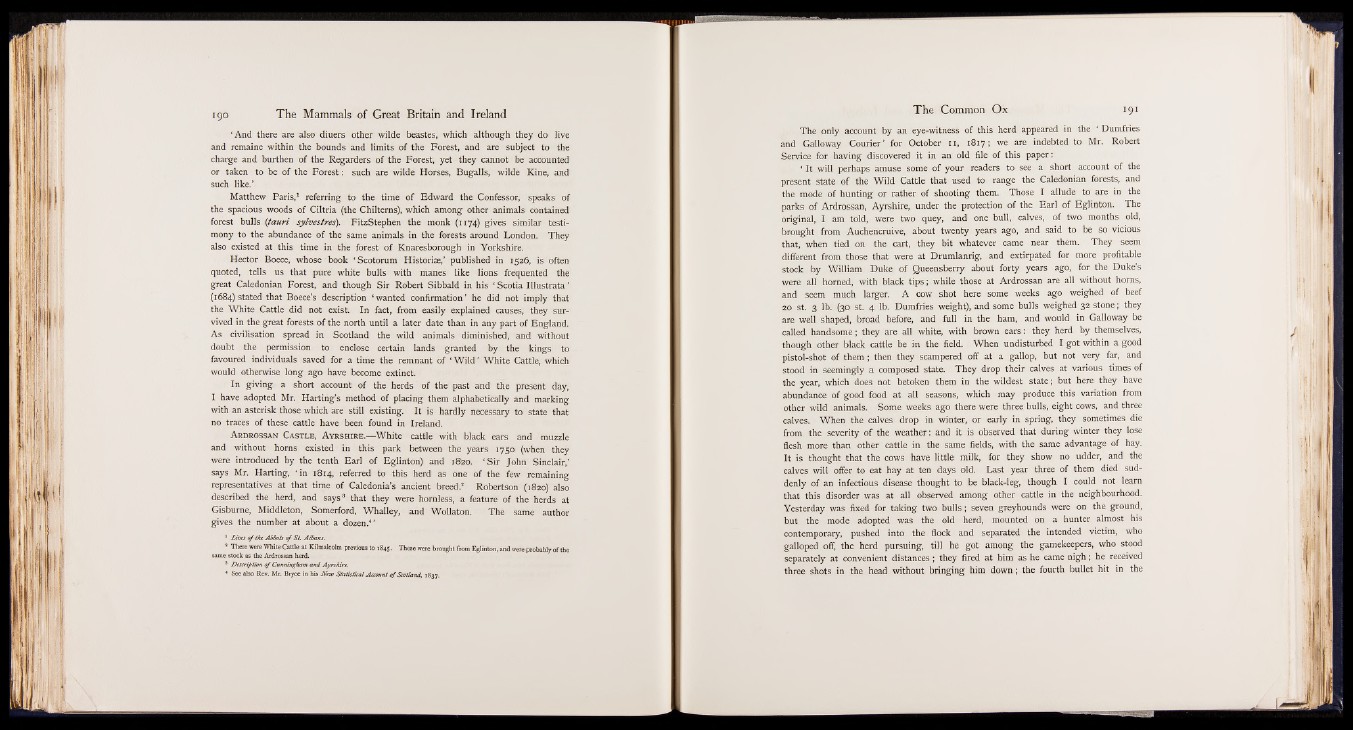
‘And there are also diuers other wilde beastes, which although they do live
and remaine within the bounds and limits of the Forest, and are subject to the
charge and burthen of the Regarders of the Forest, yet they cannot be accounted
or taken to be of the Forest: such are wilde Horses, Bugalls, wilde Kine, and
such like.’
Matthew Paris,1 referring to the time of Edward the Confessor, speaks of
the spacious woods of Ciltria (the Chilterns), which among other animals contained
forest bulls {tauri sylvestres). FitzStephen the monk (1174) gives similar testimony
to the abundance of the same animals in the forests around London. They
also existed at this time in the forest of Knaresborough in Yorkshire.
Hector Boece, whose book ‘ Scotorum Historias,’ published in 1526, is often
quoted, tells us that pure white bulls with manes like lions frequented the
great Caledonian Forest, and though Sir Robert Sibbald in his ‘ Scotia Illustrata ’
(1684) stated that Boece’s description ‘ wanted confirmation’ he did not imply that
the White Cattle did not exist. In fact, from easily explained causes, they survived
in the great forests of the north until a later date than in any part of England.
As civilisation spread in Scotland the wild animals diminished, and without
doubt the permission to enclose certain lands granted by the kings to
favoured individuals saved for a time the remnant of ‘W ild ’ White Cattle, which
would otherwise long ago have become extinct.
In giving a short account of the herds of the past and the present day,
I have adopted Mr. Harting’s method of placing them alphabetically and marking
with an asterisk those which are still existing. It is hardly necessary to state that
no traces of these cattle have been found in Ireland.
A r d r o s s a n C a s t l e , A y r s h i r e .—White cattle with black ears and muzzle
and without horns existed in this park between the years 1750 (when they
were introduced by the tenth Earl of Eglinton) and 1820. ‘ Sir John Sinclair,’
says Mr. Harting, 'in 1814, referred to this herd as one of the few remaining
representatives at that time of Caledonia’s ancient breed.2 Robertson (1820) also
described the herd, and says8 that they were hornless, a feature of the herds at
Gisburne, Middleton, Somerford, Whalley, and Wollaton. The same author
gives the number at about a dozen.4’
1 Lives o f the Abbots o f St. Albans.
* There were White Cattle at Kilmalcolm previous to 1845- These were brought from Eglinton, and were probably of the
same stock as the Ardrossan herd.
s Description o f Cunningham and Ayrshire.
* See also Rev. Mr. Bryce in his New Statistical Account o f Scotland, 1837.
The only account by an eye-witness of this herd appeared in the ‘ Dumfries
and Galloway Courier’ for October n , 1817; we are indebted to Mr. Robert
Service for having discovered it in an old file of this paper:
‘ It will perhaps amuse some of your readers to see a short account of the
present state of the Wild Cattle that used to range the Caledonian forests, and
the mode of hunting or rather of shooting them. Those I allude to are in the
parks of Ardrossan, Ayrshire, under the protection of the Earl of Eglinton. The
original, I am told, were two quey, and one bull, calves, of two months old,
brought from Auchencruive, about twenty years ago, and said to be so vicious
that, when tied on the cart, they bit whatever came near them. They seem
different from those that were at Drumlanrig, and extirpated for more profitable
stock by William Duke of Queensberry about forty years ago, for the Duke’s
were all horned, with black tips; while those at Ardrossan are all without horns,
and seem much larger. A cow shot here some weeks ago weighed of beef
20 st. 3 lb. (30 st. 4 lb. Dumfries weight), and some bulls weighed 32 stone; they
are well shaped, broad before, and full in the ham, and would in Galloway be
called handsome; they are all white, with brown ears: they herd by themselves,
though other black cattle be in the field. When undisturbed I got within a good
pistol-shot of them ; then they scampered off at a gallop, but not very far, and
stood in seemingly a composed state. They drop their calves at various times of
the year, which does not betoken them in the wildest state; but here they have
abundance of good food at all seasons, which may produce this variation from
other wild animals. Some weeks ago there were three bulls, eight cows, and three
calves. When the calves drop in winter, or early in spring, they sometimes die
from the severity of the weather: and it is observed that during winter they lose
flesh more than other cattle in the same fields, with the same advantage of hay.
It is thought that the cows have little milk, for they show no udder, and the
calves will offer to eat hay at ten days old. Last year three of them died suddenly
of an infectious disease thought to be black-leg, though I could not learn
that this disorder was at all observed among other cattle in the neighbourhood.
Yesterday was fixed for taking two bulls; seven greyhounds were on the ground,
but the mode adopted was the old herd, mounted on a hunter almost his
contemporary, pushed into the flock and separated the intended victim, who
galloped off, the herd pursuing, till he got among the gamekeepers, who stood
separately at convenient distances; they fired at him as he came nigh; he received
three shots in the head without bringing him down; the fourth bullet hit in the